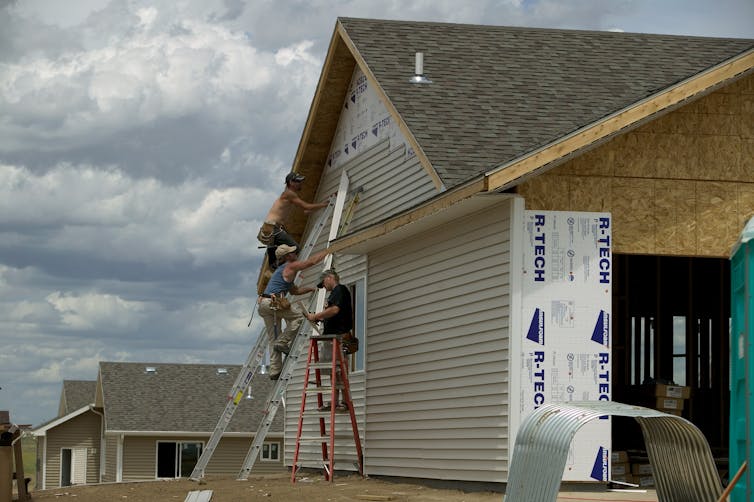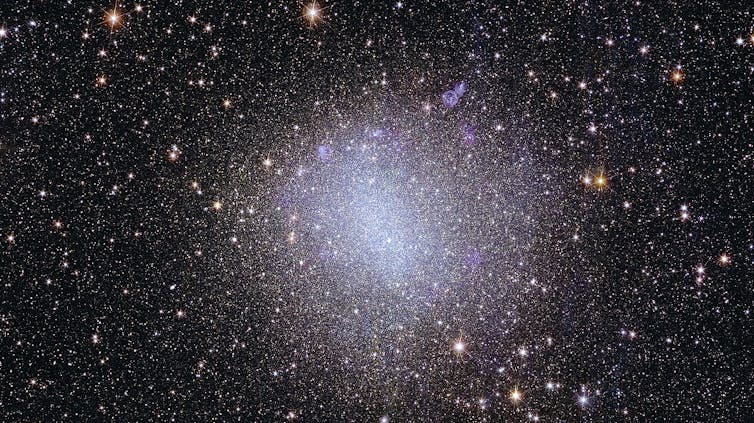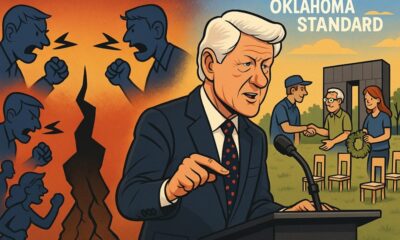
Don and Melinda Crawford/UCG/Universal Images Group via Getty Images
Tim O’Brien, Harvard Kennedy School and Tim Freeman, Harvard Kennedy School
Picture yourself living the American Dream. You likely have more opportunity than your parents did. Through hard work, smart choices and perhaps some good luck along the way, you have financial stability and a great deal of freedom to choose your next steps in life.
Chances are also good that you live in or near a vibrant community with a robust local economy.
We tend to focus on the individual aspects of the American Dream, but we also value our communities – our downtowns, little leagues, good schools, safe public spaces and local traditions. Individuals and families tend to seek out the places that provide these things along with nearby jobs. And when communities begin to lose these quality-of-life assets, residents notice. Younger people tend to migrate away.
But why do places that were once vibrant sometimes lose this quality?
This is a question that we have reckoned with as economists who study constraints to better economic growth, most recently with the state of Wyoming. We’ve found that there is an often overlooked factor shared across many different places, and understanding it is critical to helping such communities recover.
Why communities enter cycles of decline
Whether a community thrives or falls into an economic tailspin depends greatly on its ability to generate “tradable income.”
Tradable income is jargon for money generated from stuff that a local economy sells beyond its borders. This could be the crops people grow, the products that factories manufacture, the services that businesses sell, or the minerals that are pulled from the ground. This income is then circulated within the local economy in the form of demand for other jobs, such as cashiers, barbers and handymen. Tradable income is essential to import all the goods and services that are not produced locally.
Without tradable income, the rest of the local economy will struggle to survive. You can think of tradable income like the oxygen that circulates through the body of the local economy.
Rural economies nearly uniformly have fewer and less diversified sources of tradable income than urban economies. They may rely on the same main source of tradable income that was the reason the community was settled in the first place.

Matt McClain/The Washington Post via Getty Images
These economies are much more vulnerable to existential economic and environmental shocks and downward spirals of community decay than urban economies, which have built up more diversified tradable income sources over time.
Regional economies that were built on extracting and selling a natural resource, for example, can face booms and busts based on resource prices or government policies. The sudden closure of a mine can, within years, begin to wipe a community off the map. This is even though most jobs in the community were not directly supplied by the mine. The deeper and often overlooked problem is that the tradable income was tied to the mine.
This process is nothing new. It is the reason why the West has many ghost towns, and why many once-strong manufacturing towns transformed into the Rust Belt. In small communities, a regional school or even a Walmart can have the same effect if it closes, since these can be the sole sources of outside money.

Robert Nickelsberg/Getty Images
The loss of any critical source of tradable income, if not replaced, deprives the local economy of the oxygen that it needs to survive. Without new sources of tradable income, downtown stores close because businesses lack demand, joblessness rises, local tax revenue collapses and people leave.
Federal funding has a design flaw
State and federal policy has never been particularly effective at enabling local economic transitions from old sources of tradable income to new ones, or even softening the blow.
Today, it is not hard to see how climate change – as well as efforts to fight it by shutting down fossil fuel extraction and power plants – can bring new and painful shocks to local economies, just as automation and globalization have done.
The Biden administration’s recent push to build infrastructure and jump-start strategic industries – including through the Infrastructure Investment and Jobs Act, the Inflation Reduction Act and the CHIPS and Science Act – was partly driven by a desire to provide economic opportunity to parts of America that have increasingly been left behind.
Recognizing that different places have different needs, these federal efforts tended to channel resources to communities through discretionary grants rather than formula funding. In other words, the system put the responsibility on community leaders to identify funding opportunities and compete for that funding through proposed projects meeting predefined criteria, rather than have resources divided according to population or some other formula.
A key problem, however, is that most rural places do not have the local government bandwidth and staffing to navigate this system.
Town clerks and part-time local officials are often responsible for many public jobs and do not have the time or resources to navigate what can be byzantine federal funding systems. They do not have the time to absorb the flood of webinars, newsletters and online tools that federal agencies have created to circulate opportunities, let alone to mobilize successful grant applications for complicated programs with short application windows.
Not surprisingly, federal funds have tended to flow to larger municipalities with greater resources to begin with.
Wyoming, a largely rural state, is an example. The state is receiving less per capita in federal discretionary grants than most other states, and those grants are reaching relatively few communities. Our team at the Growth Lab at Harvard Kennedy School has been working with officials and residents there to find solutions.
Many folks in Wyoming believe that qualifying criteria for grants have purposefully disadvantaged the very conservative state. There are some criteria for qualifying for programs that fuel this narrative, such as grants targeted to coal communities that match the demographics and income levels of Appalachia more than Wyoming. Similarly, the lack of Medicaid expansion in the state lessens federal funding flows.
However, the main reason is much simpler and more mundane. Small and stressed communities from Wyoming to Vermont, across the political spectrum, face the same systemic obstacles in navigating the system.
Government can do better – here’s where to start
Statewide efforts have grown, including in Wyoming, to help local leaders identify and access federal grants, most importantly by building staffing and help centers that local leaders can draw upon to help navigate the federal system. But we believe a fundamentally better system is possible.
Rather than federal entities creating highly specific grant programs, inviting communities to apply and compete, and selecting winners centrally, they could flip the script when it comes to rural communities in regions that are facing shocks to tradable income.
Federal entities could instead work in concert with each other and with local leaders, starting with the place-specific needs of regional economies, and develop custom projects accordingly. Instead of shopping around centrally designed programs, federal agencies could do more to empower and support locally determined transformation efforts.
This was the spirit of the Recompete Pilot Program of the U.S. Economic Development Administration, which awarded six large grants last year among many, many locally driven proposals from economically distressed areas. A similar shift in approach was a key takeaway of the federal government’s Interagency Working Group on Coal and Power Plant Communities and Economic Revitalization, whose recent progress report looking back at three years of work emphasizes a greater need for working with, rather than imposing on, local leaders and coalitions.
Developing new pathways for tradable income will rarely be easy or fast, but this is one better place to start.![]()
Tim O’Brien, Senior Manager of Applied Research, Growth Lab, Harvard Kennedy School and Tim Freeman, Research Fellow, Growth Lab, Harvard Kennedy School
This article is republished from The Conversation under a Creative Commons license. Read the original article.






























































